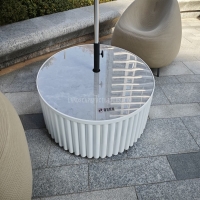Welcome to the website for landscape facilities products and knowledge.
What are the best practices for anchoring a landscape bar counter to prevent movement in windy conditions?
Installing a landscape bar counter requires robust anchoring solutions to prevent displacement during high winds. Professional landscapers recommend beginning with substantial concrete footings that extend below the frost line, typically 36-48 inches deep depending on your climate zone. These footings should be reinforced with steel rebar cages to provide structural integrity against lateral forces.
For permanent installations, consider using galvanized ground anchors specifically designed for outdoor structures. These screw-type anchors twist deep into the soil and provide exceptional resistance to uplift forces. Combine these with stainless steel brackets that connect the bar's framework to the anchored points, creating a unified structural system.
The bar counter itself should incorporate wind mitigation design elements. Incorporate strategic cross-bracing within the framework and consider adding weight to the base structure through integrated storage compartments filled with equipment or built-in planters with soil mass. These elements lower the center of gravity and significantly improve stability.
Select materials that can withstand environmental stresses. Powder-coated aluminum frameworks offer excellent strength-to-weight ratios while resisting corrosion. For counter surfaces, consider composite materials that won't warp or crack under changing weather conditions. Regularly inspect all connection points and anchors seasonally, tightening any hardware that may have loosened over time.
Proper drainage around the installation prevents soil erosion that could compromise anchor systems. Create a gravel base layer beneath the structure to facilitate water runoff while maintaining soil compaction around anchor points. For extreme wind zones, consult structural engineers about supplemental anchoring systems such as helical piles or concrete deadmen anchors placed at strategic points beneath the structure.
The integration of windbreaks represents another effective strategy. Position natural windbreaks like hedges or constructed screens strategically to disrupt wind patterns before they reach the bar area. These barriers reduce wind load on the structure itself, decreasing the forces acting upon your anchoring system.
Always check local building codes regarding permanent structure installations, as requirements vary significantly by region. Many municipalities require permits for permanently anchored structures, particularly those connected to electrical or plumbing systems. Professional installation often proves worthwhile for ensuring both safety compliance and long-term durability against severe weather conditions.
Related search:

Recommendation
Round metal tube border design table with tempered glass or granite countertop on the top.